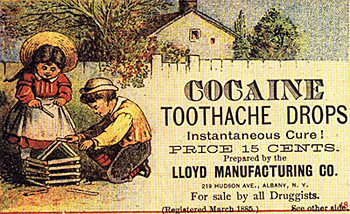 |
 |
 |
 Health & Beauty | February 2007 Health & Beauty | February 2007  
Peace: Before the War on Drugs
 American Heritage American Heritage


| | This is a typical advertisement, from a typical magazine, back in the days before the war on drugs. |
In American Heritage Feb./Mar. 1993:42-48. Ethan A Nadelmann wrote:

In turn-of-the century America, opium, morphine, heroin, cocaine, and marijuana were subject to few restrictions. Popular tonics such as Vin Mariani and Coca-Cola and its competitors were laced with cocaine, and hundreds of medicines - Mrs. Winslow's Soothing Syrup may have been the most famous - contained psychoactive drugs. Millions, perhaps tens of millions of Americans, took opiates and cocaine. David Courtwright estimates that during the 1890s as many as one-third of a million Americans were opiate addicts, but most of them were ordinary people who would today be described as occasional users.

Careful analysis of that era - when the very drugs that we most fear were sidely and cheaply available throughout the country - provides a telling antidote to our nightmare legalization scenarios. For one thing. despite the virtual absence of any controls on availability, the proportion of Americans addicted to opiates was only two or three times greater than today. For another, the typical addict was not a young black ghetto resident but a middle-aged white Southern woman or a West Coast Chinese immigrant. The violence, death, disease, and crime that we today associate with drug use barely existed, and many medical authorities regarded opiate addiction as far less destructive than alcoholism (some doctors even prescribed the former as treatment for the latter). Many opiate addicts, perhaps most, managed to lead relatively normal lives and kept their addictions secret even from close friends and relatives. That they were able to do so was largely a function of the legal status of their drug use.

But even more reassuring is the fact that the major causes of opiate addiction then simply do not exist now. Late nineteenth-century Americans became addicts principally at the hands of physicians who lacked modern medicines and were unaware of the addictive potential of the drugs they prescribed. Doctors in the 1860s and 1870s saw morphine injections as a virtual panacea, and many Americans turned to opiates to alleviate their aches and pains without going through doctors at all. But as medicine advanced, the levels of both doctor- and self-induced addiction declined markedly.

On June 27, 1991, the Supreme Court upheld, by a vote of five to four, a Michigan statute that imposed a mandatory sentence of life without possibility of parole for anyone convicted of possession of more than 650 grams (about 1.5 pounds) of cocaine. In other words, an activity that was entirely legal at the turn of the century, and that poses a danger to society roughly comparable to that posed by the sale of alcohol and tobacco, is today treated the same as first-degree murder.

Precedents for each of these penalties scarcely exist in American history. The restoration of criminal forfeiture of property - rejected by the Founding Fathers because of its association with the evils of English rule - could not have found its way back into American law but for the popular desire to give substance to the rhetorical war on drugs.

History holds one final lesson for those who cannot imagine any future beyond drug prohibition. Until well into the 1920s most Americans regarded Prohibition as a permanent fact of life. As late as 1930 Sen. Morris Shepard of Texas, who had coauthored the Prohibition Amendment, confidently asserted: "There is as much chance of repealing the Eighteenth Amendment as there is for a humming-bird to fly to the planet Mars with the Washington Monument tied to its tail."

History reminds us that things can and do change, that what seems inconceivable today can seem entirely normal, and even inevitable, a few years hence. So it was with Prohibition, and so it is - and will be - both with drug prohibition and the ever-changing nature of drug use in America. | 
 | |
 |



